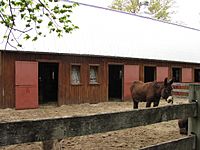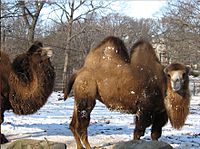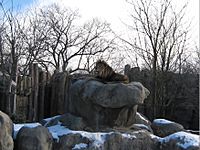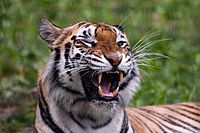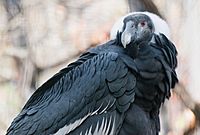Franklin Park Zoo facts for kids
| Date opened | October 4, 1912 |
|---|---|
| Location | Boston, Massachusetts, United States |
| Land area | 72 acres (29 ha) |
| Coordinates | 42°18′19″N 71°05′21″W / 42.3052°N 71.0891°W |
| No. of animals | 1000+ |
| No. of species | 220 |
| Memberships | AZA |
| Major exhibits | 63 exhibits. Highlights are, Nature's Neighborhoods, Farmyard, Outback Trail, Bird's World, Serengeti Crossing, Giraffe Savanna, Tropical Forest, Kalahari Kingdom |
The Franklin Park Zoo is a fun place to visit in Boston, Massachusetts. It's a big zoo, covering about 72 acres. This is like having 54 football fields! The zoo is managed by Zoo New England. This group also takes care of the Stone Zoo in Stoneham, Massachusetts. You can find the Franklin Park Zoo inside Franklin Park. This is Boston's largest park and part of the famous Emerald Necklace park system.
The zoo first opened its doors to the public in 1912. The City of Boston managed it until 1958. Then, the Metropolitan District Commission (MDC) took over. Under the MDC, new exhibits were added. These included Bird's World, the Children's Zoo, and the African Tropical Forest.
In 1991, a private group called the Commonwealth Zoological Corporation (CZS) started managing the zoo. This group was later renamed Zoo New England in 1997. Since 1990, the zoo has been approved by the Association of Zoos and Aquariums (AZA). This means it meets high standards for animal care.
Contents
History of the Zoo
Frederick Law Olmsted, who designed Franklin Park, had ideas for a zoo. He imagined a natural area for local animals. However, the Franklin Park Zoo officially opened on October 4, 1912. This new zoo, designed by Arthur A. Shurtleff, featured more exotic animals.
The zoo was managed by the Boston Parks Department. It was free to enter and very popular. In 1920, about two million people visited the zoo!
Changes Over Time
Sadly, the zoo faced tough times during the Great Depression and World War II. In 1958, the Metropolitan District Commission (MDC) took control. They started charging admission fees. Some older areas, like the elephant house, were separated from the zoo.
The zoo then got its first trained zoologist, Walter D. Stone, as director. An animal hospital and the Children's Zoo were added in 1962. In 1970, the Boston Zoological Society helped manage the zoo.
In 1973, a big plan was made to update the zoo. This plan included new exhibits with an African theme. Construction began in 1978. It took a long time because of money problems.
New Exhibits and Growth
On July 1, 1984, the Children's Zoo reopened after big updates. It became the zoo's most popular spot. The new African Tropical Forest Pavilion opened on September 9, 1989. It took 11 years to build and cost $26 million.
In 1990, the zoo was officially approved by the American Association of Zoological Parks and Aquariums (AAZPA). This was a big achievement! After this, the number of visitors jumped to 200,000.
In 1991, the Commonwealth Zoological Corporation (now Zoo New England) took over. They also started managing the Stone Zoo. In the late 1990s, many new exhibits were built. These included Bongo Congo (1997), Outback Trail (1998), and Butterfly Landing (1998). Today, the zoo is doing well and continues to grow.
Zoo in Pop Culture
The 2011 movie Zookeeper, starring Kevin James, was filmed at the zoo in 2009. A special screening of the movie was held at the zoo in 2011 to raise money for charity.
Explore the Exhibits
The Franklin Park Zoo is home to more than 220 different kinds of animals. Here are some of the main areas you can explore:
The Tropical Forest
This huge building is about 3 acres big. It has a giant dome roof made of a special material. The building looks like the animals' natural homes. It has streams, fake rocks, and hidden fences. Many free-flight birds fly around inside!
You can see gorillas, bats, dwarf crocodiles, ocelots, and ring-tailed lemurs here. There are also pygmy hippos and giant anteaters. In 2007, the gorilla exhibit was updated and reopened.
Serengeti Crossing
This 4-acre exhibit is like the Serengeti grasslands in Africa. You can see ostriches, blue wildebeests, Grant's zebras, and warthogs. It first opened in 1997. In 2018, it was updated with a new path.
Kalahari Kingdom
This large area has an African theme. It's home to two male African lion brothers. You can watch them through glass or from a special "crashed" land rover. This exhibit opened in 1997.
Other animals here include Siberian tigers, Bengal tigers, and red river hogs. You might also spot bongo and large African spurred tortoises.
Outback Trail
Step into the Australian Outback here! You can see kangaroos, cockatoos, emus, and Tawny frogmouth. This exhibit opened around 1998. There's also a seasonal aviary where you can feed budgerigars.
Giraffe Savannah
Opened in 1999, this is a large space for Masai giraffes. Grevy's zebras also live with them. You can also see wattled cranes nearby.
Bird's World
This big building has an Asian-inspired outside. Inside, you'll find many bird species in four different environments. These include a swamp, rainforest, desert, and wetlands.
Outside, there's a large flight cage for big birds like Andean condors and Steller's sea eagles. You can also see kookaburras and Indian peacocks. This building first opened in 1912 and was updated in the 1970s.
Butterfly Landing
This is a seasonal exhibit that's open during warmer months. It's a large outdoor "tent" filled with over 1,000 butterflies flying freely. It also has streams and a waterfall. This exhibit first opened in 1997.
Nature's Neighborhood
This is the zoo's Children's Zoo, covering three acres. It has a walk-through aviary with different birds. You can also see prairie dogs, red pandas, turtles, and reeve's muntjac.
Inside Nature's Neighborhood is Franklin Farm. This barn has areas for farm animals. You can interact with goats! Animals here include Poitou Donkeys, ponies, llamas, chickens, and Nigerian Dwarf goats. In 2020, Java green peacocks joined the farm.
Outside the Tropical Forest, there's also an exhibit for spotted hyenas. It opened in 2014.
Zoo Visitors Over the Years
The number of people visiting the zoo has been growing recently. However, it hasn't reached the high numbers from when it was free to enter. The zoo hopes to welcome one million visitors in the future!
Here's a look at how many people visited over the years:
- 1920: 2 million visitors (when the zoo was free)
- 1984: 100,000 visitors (after the updated Children's Zoo opened)
- 1988: 35,000 visitors
- 1990: 200,000 visitors (after the African Tropical Forest opened)
- 1993: 132,832 visitors
- 1994: 153,310 visitors
- 1996: 130,000 visitors
- 1997: 130,000 visitors
- 1998: 240,000 visitors
- 2006: 266,997 visitors
- 2007: 308,166 visitors
- 2008: 326,543 visitors
- 2009: 342,313 visitors
- 2014: 418,167 visitors
- 2016: 353,891 visitors
Images for kids


